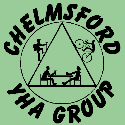
CYHA News
The Monthly Newsletter of Chelmsford YHA Local Group
October 2014
Border Reivers
With the Scottish Referendum high on the political agenda, what better time could there be to examine the security of our northern border. As it turns out the Cheviot Hills have no watchtowers or passport control, just mile after mile of rolling landscape. There was a bit of a fence, but it was only waist high and there were gates every few hundred yards.
Over the centuries there has been a lot of friction along the border, with prominent families on either side raiding each other in a series of revenge attacks sometimes spanning generations. Thieving, murder and one-upmanship was the order of the day, and in the East March there were the Selbys in England and the Dixons in Scotland. Somehow Jim and I have managed to get over our ancestral differences, but I couldn’t resist a couple of trips across that rather flimsy fence…
The first part of our August week in Northumberland was spent at Cragside, a fascinating house built into a rocky hillside and an early adopter of domestic electricity, light bulbs and the telephone. Plenty of stuff for us to geek over, plus gorgeous grounds to wander about in. For four days we were staying within a stone’s throw of a National Trust tearoom, yet there was never the time to actually sample their wares – there was just too much other stuff to do.
We had a day in the Simonside Hills strolling through heather clad moors scattered with iron age forts and ring-marked rocks. Another day was spent on the coast walking from Beadnell to Craster, via the romantic ruin of Dunstanburgh Castle. Yet another had us grockling around Alnwick Castle alongside the Harry Potter wannabes. There were visits to Lindisfarne and the Farne Islands, and you couldn’t possibly go all that way and miss out Berwick-upon-Tweed. What with that and a couple of days climbing in the Cheviots, the week was over before we knew it. It’s no use, we’ll just have to go back.
Ali
Having a Wild Time
If anyone had told me that I would spend an hour watching cows in a field in rapt fascination and spend £6 for the privilege, I would have thought them mad. Yet on our visit to Chillingham in Northumberland this was exactly what I did. The cows are smallish, whiteish, and without the spiel from the warden you might not have given them a second glance. However the cows are descendents of the wild cows that would have roamed free across much of northern Britain in the middle ages.
During the 13th century the grounds of Chillingham Park were enclosed by a massive wall, which isolated the herd from the outside world. Then the owners of Chillingham made a conscious decision to keep the animals wild, so they could have the thrill of hunting them. And these cows are very wild. You can’t approach them, and a human touch would alter the smell of the animal and result in rejection from the herd and possibly death. The bulls exhibit natural behaviour and will challenge each other for supremacy, and anyone they see as a threat. They have been know to fight to the death and, when they were hunted, were responsible for the occasional human death too.
Isolated for about 800 years, the wild cattle are now so different to normal cows that they cannot interbreed to produce fertile offspring. It seems they may have more in common with the now extinct aurochs that you see in prehistoric cave paintings. Who’d have thought cows could be so interesting.
Ali
Please send any comments on these pages to Dave Plummer